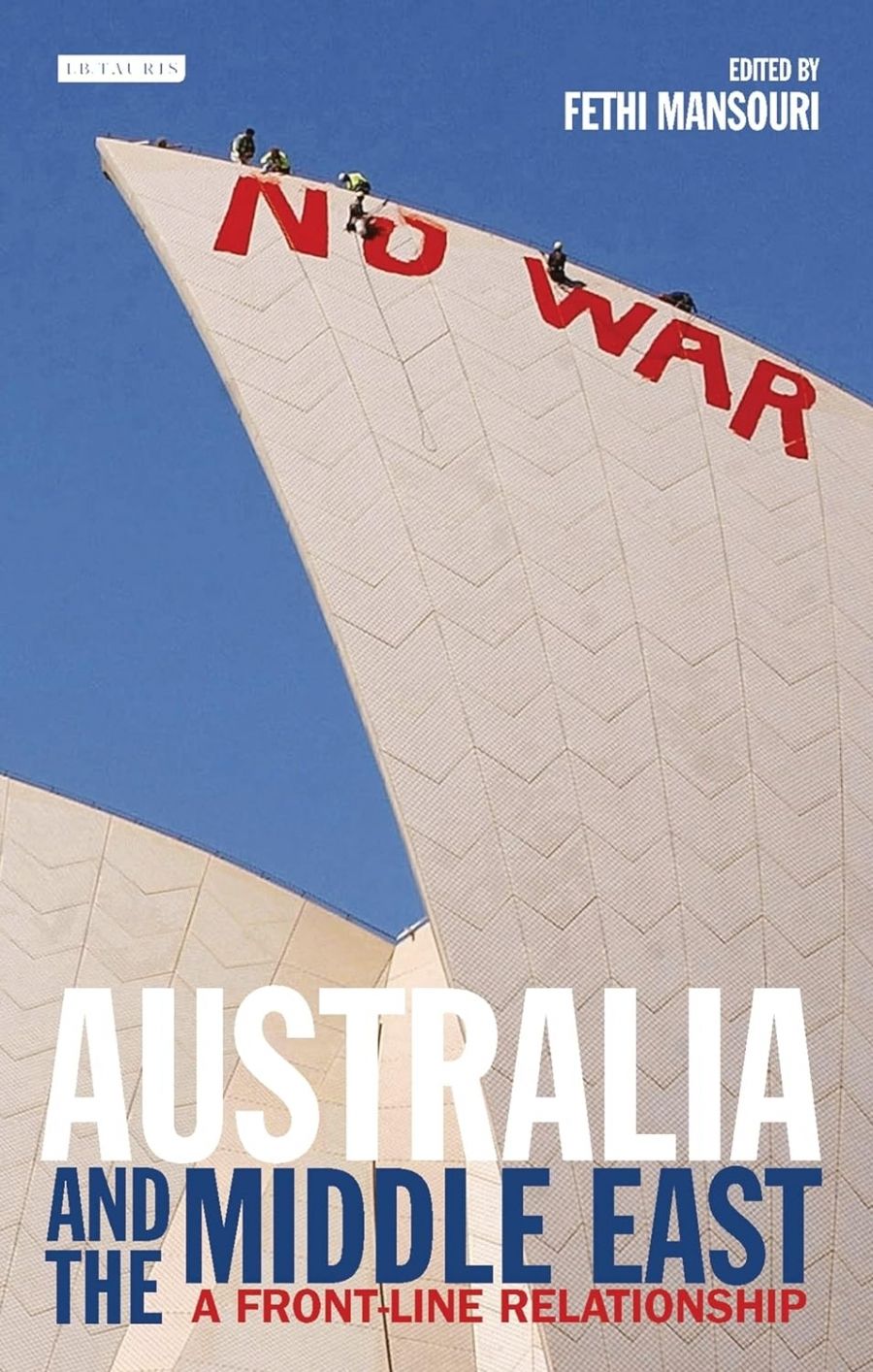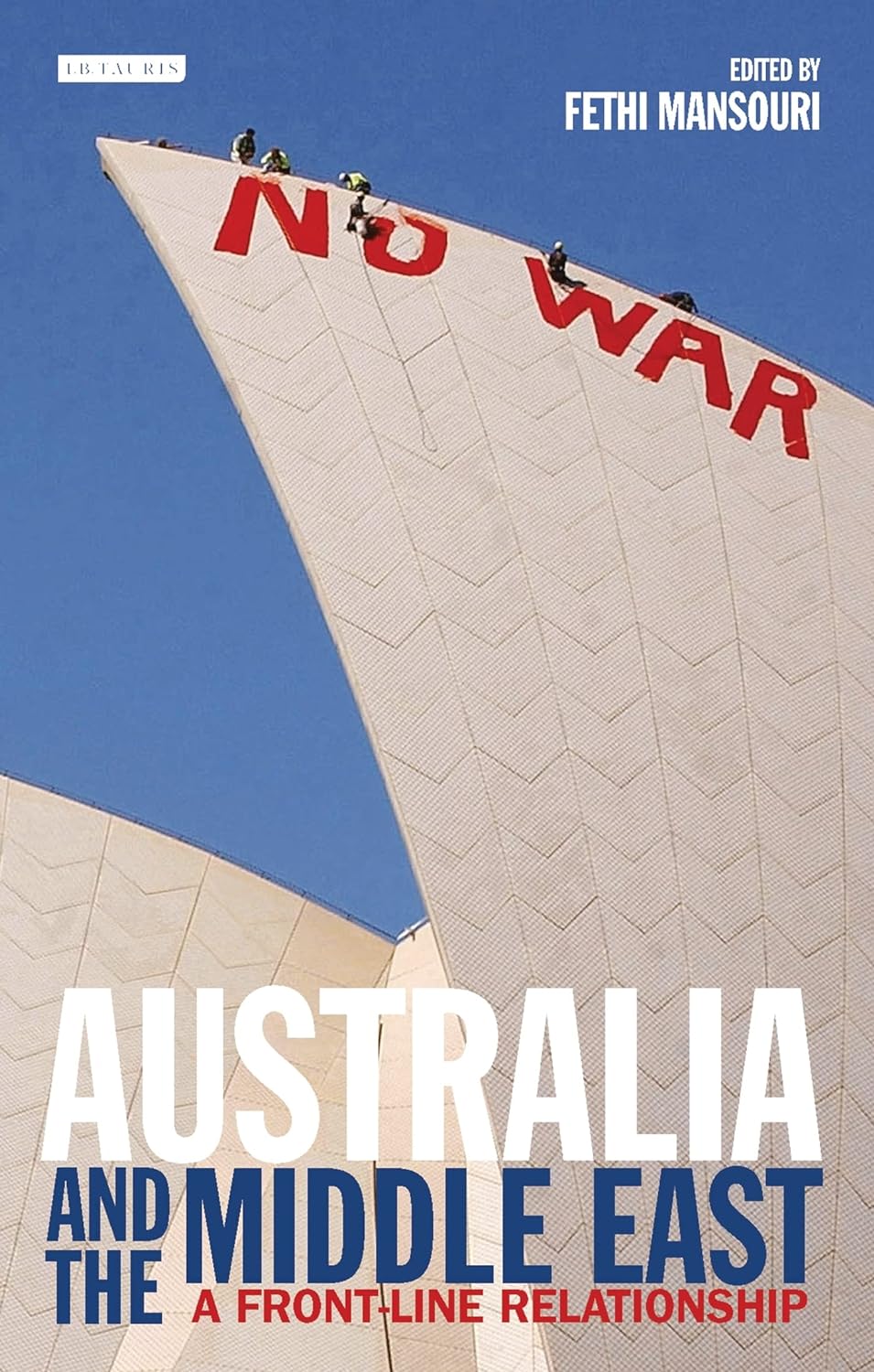
- Free Article: No
- Custom Article Title: The lessons of civilising imperialism
- Review Article: Yes
- Article Title: The lessons of civilising imperialism
- Online Only: No
- Custom Highlight Text:
In recent years, particularly since the Tampa and children overboard incidents and the 9/11 attacks, there has been a marked change in public and political perceptions of Middle Eastern migrants and the Arab–Australian community. In August 2001, for instance, the chair of a parliamentary inquiry into Australia’s relations with the Middle East, David Jull, introduced the committee’s report with the ‘reassuring’ observation that ‘for the most part, the tensions and conflict in the Middle East have not affected the relations between the various community groups in Australia’.
- Book 1 Title: Australia and the Middle East
- Book 1 Subtitle: A front-line relationship
- Book 1 Biblio: I.B. Tauris, $49.95 hb, 259 pp, 1845112091
- Book 1 Cover Small (400 x 600):

- Book 1 Cover (800 x 1200):

To some extent, this remains true. Whereas the tensions in the Balkans occasionally resulted in direct conflicts between Australia’s Serbian and Croatian communities, conflicts in the Middle East have rarely spilt over into intercommunity violence in Australia. But the tensions in the Middle East have contributed to a recent unfortunate phenomenon in which a noticeable chasm has opened between Middle Eastern Australians and ‘mainstream’ Australians. Since the 2001 parliamentary report, released a week after 9/11, Arab and Muslim Australians have been at the centre of bitter, public debates about asylum seekers, crimes by Lebanese Australians in south-west Sydney, the Cronulla riots, and recent comments about women and sexual assault by the Australian mufti, Sheik al-Hilaly.
It is this chasm which Australia and the Middle East: A Front-Line Relationship, a collection of essays dealing with Australia’s involvement with the Middle East, seeks in part to redress. Abdullah Saeed, a professor of Arab and Islamic studies at the University of Melbourne, writes in a chapter on the recent history of the Muslim community in Australia:
As in many other western countries, Islam has an image problem in the Australian print and electronic media … In taking the worst aspects of Muslim behaviour and presenting them as the normative standard rather than the exception, an understanding of the cultural, linguistic and ethnic richness and diversity of Muslin communities is discouraged … It must be said that the efforts on the part of the Muslim community to manage the response to the stereotyping of Muslims is still in its early stages and it may take some time for the community to develop a sophisticated infrastructure to respond to such issues in a more co-ordinated and organised fashion.
But the book does not seek to provide an historical account of Islam’s ‘image problem’ in Australia. Instead, it deals more broadly with various aspects of Australia’s Middle East engagement. The editor, Fethi Mansouri, an associate professor in Middle Eastern studies at Deakin University, seeks to provide a comprehensive account of Australia’s relations with the Middle East. Contributors include Greg Barton, an associate professor in politics at Deakin, who looks at Australia’s engagement with Islam in South-East Asia, and Scott Burchill, a lecturer in international relations at Deakin, who looks at Australia’s stance towards the Israel–Palestine conflict. Other chapters focus on Australia’s trade relations with the Middle East, its attempts to foster human rights and Australia’s engagement with Arab states in North Africa.
Much of the book examines the two touchstones of these relations: Australia’s long history of military interventions in the Middle East; and the status and treatment of Australia’s Muslim and Arab-Australian migrants and communities.
David Walker, the professor of Australian studies at Deakin, shows in a chapter titled ‘Perilous Encounters’ that the image problem is a recent phenomenon. Until the ‘war on terror’, the Arab world was never regarded as a direct threat to Australian interests. This mantle belonged to Australia’s Asian neighbours, who were represented as the ‘yellow peril’, while Arabs and Muslims were generally regarded as non-menacing, somewhat backward relics of a decaying culture. At the Afro-Asian Conference in Indonesia in 1955, the presence of Islamic nations, including Indonesia, was barely noticed, according to Walker. Subsequently, a concerted effort was made in Australia to try to understand its Asian neighbours. This only accentuated the lack of knowledge of Islam and the Middle East and led to a new form of stereotyping:
It is precisely because the Arab world and Islam have not been subjected to the same familiarizing processes or the same level of sympathetic scrutiny that Islam can so powerfully represent the new, dark unknown, a world to be dismissed and repudiated rather than studied or understood. Moreover, in a world of non-State actors the ‘crazed’ Arab bent on dragging the civilized world back into darkness has both a new power and renewed cultural resonance.
Arguably, a lack of cultural and historical understanding has underscored two of the greatest failures of modern Western intervention in the Middle East: the Suez Crisis and the Iraq War. In both, Australia has played a key role by stridently supporting the foreign policies of each of its two most powerful allies. In 1956 Robert Menzies delivered a television address to the people of Great Britain to persuade them of the perils of the decision by the Egyptian President, Gamal Abdel Nasser, to nationalise the Suez Canal. Menzies interspersed his speech with a quote from Hamlet’s soliloquy about the risks of procrastination – a veiled reference to the British fear that ‘appeasing’ Nasser would repeat the mistakes of Neville Chamberlain. Menzies said: ‘You in Great Britain are concerned, for a threat to the Suez Canal will, if not resisted, encourage other acts of lawlessness and so reduce the economic strength of your country.’
Throughout the summer of 1956, Menzies took a strong stand against Nasser during the affair and sided with Britain’s prime minister, Anthony Eden, and France, rather than with the Republican leader of the United States, Dwight Eisenhower, who tried to thwart an invasion of Egypt. The repercussions of the crisis have not abated. The invasion led to Eden’s resignation, the rising supremacy of the United States over its Western allies, promoted pan-Arab nationalism and marked the humiliating demise of Britain’s and France’s imperial influence. It was a ground-shifting event with resonances far beyond the Canal – and the Australian government had played a prominent role.
The reasons for Menzies’ involvement are examined here by David Lowe, an associate professor in history at Deakin. He notes that Australia had a long history of military involvement in the Middle East, dating back to the dispatch of Australian troops to the Sudan in 1885. Then therewas Gallipoli and the battle of the Light Horse Brigade in World War I, and the campaigns in Egypt and Libya in World War II. Australians, including Menzies, were familiar with the Middle East, primarily ‘through the lesson of civilizing imperialism’.
Lowe records a visit to Egypt six years earlier in which Menzies had jotted in his diary his thoughts on the character of the country’s people: ‘These Gyppos are a dangerous lot of backward adolescents mouthing the slogans of democracy, full of self-importance and basic ignorance.’
As the Suez crisis shows, Australian governments have never been immune from the divisive conflicts of the Middle East, even though the government’s military deployments to the region have been primarily linked to preserving Australia’s relations with its global allies. However, the conflicts and tensions in the Middle East have also had a more direct impact on the shape of Australian society.
A chapter on Arab migration from the Middle East by Trevor Batrouney, an adjunct professor at RMIT University, charts the waves of migration from Arab countries, particularly Lebanon, Iraq and Egypt, which have made Arabic the fourth most widely spoken community language in Australia. Accordingly, Batrouney says, the Arab-Australian community has facilitated growing trade and cultural contacts with the Middle East. Both Batrouney and Mansouri argue that the Howard government’s policy towards asylum seekers was linked to the ethnic and cultural backgrounds of the refugees. Mansouri says the refugees were described as queue jumpers despite the absence of any real queues in receiving countries such as Pakistan, Iran and Indonesia, while John Howard justified the policy by saying he could not rule out the possibility that some asylum seekers might be linked to global terrorists. This in turn, says Mansouri, led to the disparagement of the broader Arab-Australian community:
Muslim asylum seekers, and by implication Muslim- and Arab-Australians as a cultural ‘other’, were dehumanized and Islam portrayed as threatening and dangerous to the Australian nation and Anglo-Australian values … The most revealing aspect of Australia’s radical asylum approach, in comparison to other countries, is that so few asylum seekers were needed to provoke it.


Comments powered by CComment